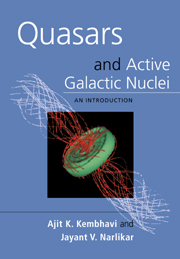Book contents
- Frontmatter
- Contents
- Preface
- Acknowledgments
- Acronyms and abbreviations
- 1 HISTORICAL BACKGROUND
- 2 THE COSMOLOGICAL FRAMEWORK
- 3 RADIATIVE PROCESSES–I
- 4 RADIATIVE PROCESSES–II
- 5 THE STANDARD MODEL
- 6 SURVEYS
- 7 LUMINOSITY FUNCTIONS
- 8 THE CONTINUUM
- 9 RADIO PROPERTIES
- 10 X-RAY EMISSION
- 11 X-RAY AND GAMMA-RAY SPECTRA
- 12 UNIFICATION
- 13 QUASAR ABSORPTION LINES
- 14 GRAVITATIONAL LENSING
- 15 PROBLEMS AND CONTROVERSIES
- References
- Books, reviews and proceedings
- Author index
- Subject index
2 - THE COSMOLOGICAL FRAMEWORK
Published online by Cambridge University Press: 05 June 2012
- Frontmatter
- Contents
- Preface
- Acknowledgments
- Acronyms and abbreviations
- 1 HISTORICAL BACKGROUND
- 2 THE COSMOLOGICAL FRAMEWORK
- 3 RADIATIVE PROCESSES–I
- 4 RADIATIVE PROCESSES–II
- 5 THE STANDARD MODEL
- 6 SURVEYS
- 7 LUMINOSITY FUNCTIONS
- 8 THE CONTINUUM
- 9 RADIO PROPERTIES
- 10 X-RAY EMISSION
- 11 X-RAY AND GAMMA-RAY SPECTRA
- 12 UNIFICATION
- 13 QUASAR ABSORPTION LINES
- 14 GRAVITATIONAL LENSING
- 15 PROBLEMS AND CONTROVERSIES
- References
- Books, reviews and proceedings
- Author index
- Subject index
Summary
Introduction
The third decade of the twentieth century brought about a significant advance in our perception of the universe. In particular, it became clear to the astronomer that our Milky Way galaxy is but one amongst many such galaxies. And, what is more, the vast collection of galaxies appeared to be boundless (even as it does today). Towards the end of the decade Edwin Hubble came up with the remarkable discovery that the spectra of galaxies appear to be shifted towards the red end of the spectrum, and that the shift in a given galaxy is proportional to the distance of the galaxy from us. Hubble's actual observations showed that redshift increases with increasing faintness of the galaxies. Distance is inferred from the inverse square law of illumination. If we interpret the spectral shift as due to the Doppler effect, the corresponding radial velocity is then proportional to distance. The constant of proportionality is known as Hubble's constant and its value is denoted by H0.
Since the discovery of Hubble's law in 1929, evidence has steadily grown that, barring very few exceptions, the phenomenon of redshift is universally found in all extragalactic objects. The theoreticians have had no difficulty in explaining the phenomenon; in fact, seven years before Hubble, A. Friedmann had found world models as solutions of Einstein's equations of general relativity wherein the property of redshift arose naturally.
- Type
- Chapter
- Information
- Quasars and Active Galactic NucleiAn Introduction, pp. 12 - 30Publisher: Cambridge University PressPrint publication year: 1999

